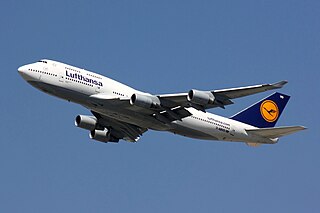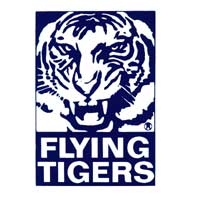Fleet

As of its end in 1983, Pan Am Cargo fleet included:
- 4 Boeing 727 (1 in Mexico City)
- 2 Boeing 747-123F
- 2 Boeing 747-221F
- 1 Boeing 747-273C (Leased from World Airways)
| |||||||
| Ceased operations | 1983 | ||||||
|---|---|---|---|---|---|---|---|
| Hubs | New York-JFK | ||||||
| Parent company | Pan Am | ||||||
Pan Am Cargo or Clipper Cargo was a subsidiary cargo airline of Pan American World Airways. Pan Am Cargo first used piston-engined aircraft such as the Douglas DC-4. On 5 January 1952 the larger DC-6 model was used on the company's first transatlantic all-cargo service. In 1963, Pan Am's all-cargo jet service began with Boeing 707-321Cs that henceforth dominated Pan Am's freight operations.

As of its end in 1983, Pan Am Cargo fleet included:

The Boeing 747 is a large, long-range wide-body airliner designed and manufactured by Boeing Commercial Airplanes in the United States between 1968 and 2023. After introducing the 707 in October 1958, Pan Am wanted a jet 2+1⁄2 times its size, to reduce its seat cost by 30%. In 1965, Joe Sutter left the 737 development program to design the 747, the first twin-aisle airliner. In April 1966, Pan Am ordered 25 Boeing 747-100 aircraft, and in late 1966, Pratt & Whitney agreed to develop the JT9D engine, a high-bypass turbofan. On September 30, 1968, the first 747 was rolled out of the custom-built Everett Plant, the world's largest building by volume. The first flight took place on February 9, 1969, and the 747 was certified in December of that year. It entered service with Pan Am on January 22, 1970. The 747 was the first airplane called a "Jumbo Jet" as the first wide-body airliner.

Pan American World Airways, originally founded as Pan American Airways, and commonly known as Pan Am, was an American airline that was the principal and largest international air carrier and unofficial overseas flag carrier of the United States for much of the 20th century. It was the first airline to fly worldwide and pioneered numerous innovations of the modern airline industry, such as jumbo jets and computerized reservation systems. Until its dissolution in 1991, Pan Am "epitomized the luxury and glamour of intercontinental travel", and it remains a cultural icon of the 20th century, identified by its blue globe logo, the use of the word "Clipper" in its aircraft names and call signs, and the white uniform caps of its pilots.

Cargolux, legally Cargolux Airlines International S.A., is a Luxembourgish flag carrier cargo airline with its headquarters and hub at Luxembourg Airport. With a global network, it is one of the largest scheduled all-cargo airlines in Europe. Charter flights and third party maintenance are also operated. It has 85 offices in over 50 countries as of 2018, and operates a global trucking network to more than 250 destinations.
Kalitta Air is an American cargo airline headquartered at Willow Run Airport, Ypsilanti Township, Michigan. The company operates international scheduled and cargo charter services. Its call sign "Connie" is from its founder, Connie Kalitta.

Juan Terry Trippe was an American commercial aviation pioneer, entrepreneur and the founder of Pan American World Airways, one of the iconic airlines of the 20th century. He was involved in the introduction of the Sikorsky S-42, which opened trans-Pacific airline travel, the Boeing 307 Stratoliner which introduced cabin pressurization to airline operations, the Boeing 707 which started a new era in low cost jet transportation, and the Boeing 747 jumbo jets. Trippe's signing of the 747 contract coincided with the 50th anniversary of Boeing.
All Nippon Airways Co., Ltd., also known as ANA (Ē-enu-ē) or Zennikkū (全日空) is an airline of Japan. Its headquarters are located in Shiodome City Center in the Shiodome area of Minato ward of Tokyo. It operates services to both domestic and international destinations and had more than 20,000 employees as of March 2016.
This is a list of aviation-related events from 1983.

Braniff Airways, Inc., operated as Braniff International Airways from 1948 until 1965, and then Braniff International from 1965 until air operations ceased, was an airline in the United States that once flew air carrier operations from 1928 until 1982 and continues today as a retailer, hotelier, travel service and branding and licensing company, administering the former airline's employee pass program and other airline administrative duties. Braniff's routes were primarily in the midwestern and southwestern United States, Mexico, Central America, and South America. In the late 1970s it expanded to Asia and Europe. The airline ceased air carrier operations in May 1982 because of high fuel prices, credit card interest rates and extreme competition from the large trunk carriers and the new airline startups created by the Airline Deregulation Act of December 1978. Two later airlines used the Braniff name: the Hyatt Hotels-backed Braniff, Inc. in 1983–89, and Braniff International Airlines, Inc. in 1991–92.
EVA Airways Corporation, of which "EVA" stands for Evergreen Airways, is one of the two largest airlines of Taiwan, at Taoyuan International Airport near Taipei, Taiwan, operating passenger and dedicated cargo services to over 40 international destinations in Asia, Australia, Europe, and North America. EVA Air is largely privately owned and flies a fully international route network. It is a 5-star airline, rated by Skytrax. It is the second largest Taiwanese airline. EVA Air is headquartered in Luzhu, Taoyuan City, Taiwan. The company slogan is "Sharing the World, Flying Together".

The Boeing 747-400 is a large, long-range wide-body airliner produced by Boeing Commercial Airplanes, an advanced variant of the initial Boeing 747. The "Advanced Series 300" was announced at the September 1984 Farnborough Airshow, targeting a 10% cost reduction with more efficient engines and 1,000 nautical miles (1,900 km) of additional range. Northwest Airlines (NWA) became the first customer with an order for 10 aircraft on October 22, 1985. The first 747-400 was rolled out on January 26, 1988, and made its maiden flight on April 29, 1988. Type certification was received on January 9, 1989, and it entered service with NWA on February 9, 1989.

Boeing Field, officially King County International Airport, is a public airport owned and operated by King County, five miles south of downtown Seattle, Washington. The airport is sometimes referred to as KCIA, but it is not the airport identifier. The airport has scheduled passenger service operated by Kenmore Air, a commuter air carrier, and was being served by JSX with regional jet flights. It is also a hub for UPS Airlines. It is also used by other cargo airlines and general aviation aircraft. The airfield is named for the founder of Boeing, William E. Boeing and was constructed in 1928, serving as the city's primary airport until the opening of Seattle–Tacoma International Airport in 1944. The airport's property is mostly in Seattle just south of Georgetown, with its southern tip extending into Tukwila. The airport covers 634 acres (257 ha), averages more than 180,000 operations annually, and has approximately 380 based aircraft.

Hilo International Airport, formerly General Lyman Field, is an international airport located in Hilo, Hawaiʻi County, Hawaiʻi. Owned and operated by the Hawaiʻi state Department of Transportation, it is one of two major airports on Hawaiʻi Island and one of five major airports in the state. Hilo International Airport serves most of East Hawaiʻi, including the districts of Hilo and Puna, as well as portions of the districts of Hāmākua and Kaʻū. Most flights to the airport are from Honolulu International Airport. These flights are predominantly operated by Hawaiian Airlines, Aloha Air Cargo, and its newest operator, Southwest Airlines. The airport encompasses 1,007 acres (408 ha) of land.

Flying Tiger Line, also known as Flying Tigers, was the first scheduled cargo airline in the United States and a major military charter operator during the Cold War era for both cargo and personnel. The airline was bought by Federal Express in 1988.

Combi aircraft in commercial aviation are aircraft that can be used to carry either passengers as an airliner, or cargo as a freighter, and may have a partition in the aircraft cabin to allow both uses at the same time in a mixed passenger/freight combination. The name combi comes from the word combination. The concept previously existed in railroading, as a passenger car that contained a separate compartment for mail and/or baggage.

Brownsville/South Padre Island International Airport is 5 miles east of downtown Brownsville, Cameron County, Texas.

Nigeria Airways Ltd., more commonly known as Nigeria Airways, was a Nigerian airline. The company was founded in 1958 after the dissolution of West African Airways Corporation (WAAC). It held the name West African Airways Corporation Nigeria until 1971, when it was rebranded to the name it had until it ceased operations in 2003. The government of Nigeria owned a majority of the airline (51%) until 1961, when it boosted its shareholding in the company to 100% and made it the country's flag carrier. At the time of dissolution, the airline's headquarters were at Airways House in Abuja. Operations were concentrated at Murtala Muhammed International Airport and served both domestic and international destinations mainly concentrated in West Africa; the network also had points in Europe, North America and Saudi Arabia. The airline was managed by a number of foreign companies, including British Airways, KLM and South African Airways.
A government contract flight is a type of charter airline operation contracted with a government agency.

The Boeing 747SP is a shortened version of the Boeing 747 wide-body airliner, designed for a longer range. Boeing needed a smaller aircraft to compete with the McDonnell Douglas DC-10 and Lockheed L-1011 TriStar tri-jet wide-bodies, introduced in 1971/1972. Pan Am requested a 747-100 derivative to fly between New York and the Middle East, a request also shared by Iran Air, and the first order came from Pan Am in 1973.
British Airways World Cargo, formerly British Airways Cargo, was a division of IAG Cargo, operating air cargo services under the British Airways brand. It was the twelfth-largest cargo airline in the world by total freight tonne-kilometres flown. Freight services were provided using the main British Airways fleet, as well as dedicated freighter aircraft operating under a wet lease agreement with Global Supply Systems.

Wake Island Airfield is a military air base located on Wake Island, which is known for the Battle of Wake Island during World War II. It is owned by the U.S. Air Force and operated by the 611th Air Support Group. The runway can be used for emergency landings by commercial jetliners flying transpacific routes and has been used in the past by airlines operating jet, turboprop, and prop aircraft on scheduled flights.